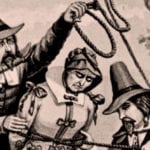 Misconceptions
Misconceptions  Misconceptions
Misconceptions  History
History 10 Amazing Roman Epitaphs
 Weird Stuff
Weird Stuff 10 Niche Subcultures That Are More Popular Than You Might Think
 Mysteries
Mysteries 10 Tragic Disappearances and Deaths in Joshua Tree National Park
 History
History 10 Ways Childhood Really Sucked in the Old West
 Music
Music 10 Name Origins of Famous Bands from the 1990s
 Religion
Religion 10 Biggest Turnarounds by the Catholic Church
 Weird Stuff
Weird Stuff 10 Unbelievable Times Laws Had Unintended Consequences
 Humans
Humans Ten Historic Women Who Deserve Way More Credit Than They Got
 Movies and TV
Movies and TV 10 Films That Spawned Major Lawsuits
 Misconceptions
Misconceptions 10 Phony Myths and Urban Legends That Just Won’t Die
 History
History 10 Amazing Roman Epitaphs
 Weird Stuff
Weird Stuff 10 Niche Subcultures That Are More Popular Than You Might Think
Who's Behind Listverse?

Jamie Frater
Head Editor
Jamie founded Listverse due to an insatiable desire to share fascinating, obscure, and bizarre facts. He has been a guest speaker on numerous national radio and television stations and is a five time published author.
More About Us Mysteries
Mysteries 10 Tragic Disappearances and Deaths in Joshua Tree National Park
 History
History 10 Ways Childhood Really Sucked in the Old West
 Music
Music 10 Name Origins of Famous Bands from the 1990s
 Religion
Religion 10 Biggest Turnarounds by the Catholic Church
 Weird Stuff
Weird Stuff 10 Unbelievable Times Laws Had Unintended Consequences
 Humans
Humans Ten Historic Women Who Deserve Way More Credit Than They Got
 Movies and TV
Movies and TV 10 Films That Spawned Major Lawsuits
Ten Historic Women Who Deserve Way More Credit Than They Got
It’s no secret that women can do just as much as men—especially in pursuits like science, art, governance, politics, and academic endeavors. And it’s sadly also no secret that women weren’t seen in this equally capable light for centuries. Men dominated all those fields seemingly forever.
While many men did impressive things to advance civilization and improve society, just as often, women were instrumental in key ways behind the scenes. Yet they didn’t receive public adulation or accolades like they probably should have.
That’s the focus of our list today, then. In this rundown, we’ll explore the stories of ten impressive women who had a major hand in changing society. But at the time when they were making their mark, they were mostly ignored—or altogether forgotten!
So, let’s right those wrongs with this long look at their incredible achievements. Here are the back-in-the-day tales of ten members of the fairer sex who worked in close quarters with the boys and produced things that completely changed the world despite receiving little to no credit for their work.
Related: 10 Inventions and Theories Made by Women but Credited to Men
10 Dorothy Vaughan
You may have never heard her name, but Dorothy Vaughan is one of the people who made NASA go during and after World War II and on into the space race of the 1950s and 1960s.
Born in 1910 in Kansas City, Missouri, Dorothy—a Black woman—was remarkably intelligent from very early in her life. As a teenager, she was awarded a full scholarship to study at Wilberforce University. Then, through the 1930s, she worked as a math teacher, trying to pass on her knowledge to young people.
When World War II broke out, the American government and business world sought capable women to replace the men drafted off to fight in the war. This is when Vaughan’s career and life took a turn. She joined a host of other Black female mathematicians at the West Area Computing Unit in 1943. That unit was part of NASA’s predecessor, then known as the National Advisory Committee for Aeronautics, or NACA.
There, she worked carefully on computing complicated mathematical equations related to both defense industry needs and spaceflight goals for the United States. Eventually, as NASA spun off into its own thing after the war and the space race began in earnest, she became the organization’s first Black manager. And a woman, no less, in such a time when science was dominated by men!
The managerial role alone made her the first Black person and the first woman to ever receive a promotion at NASA. She was technically competent, too, as she was one of the org’s earliest experts on FORTRAN, which was a forerunner to what became electronic computer programming.[1]
9 Ada Lovelace
Born in 1815 in the London area, Ada Lovelace is regarded as the world’s very first computer programmer for her pioneering and unique work on Charles Babbage’s analytical engine. During the 19th century, Babbage had the idea to produce a computer that could do calculations and analysis based on inputs. It was, in many ways, the very (very, very) early precursor to the modern computer.
Well, Lovelace analyzed the intricacies of that technology and created a program for that computer. In doing so, she became the first-ever computer programmer anywhere in the world. It all came about in 1843 when Lovelace came across a paper about the analytical engine written in French by an Italian mathematician. She translated the paper, then added a long series of her own annotations, improving it, answering its questions, and explaining how the analytical engine might function under various inputs and stressors.
Babbage loved it, and the work matched perfectly with what he’d been doing. That Lovelace was able to correctly predict how the analytical engine worked and how it might be used was a pioneering moment in connecting the dots between human programmers and the machines they were putting into use. Unfortunately for Lovelace and all the rest of us, Babbage never fully completed the analytical engine, nor did he take it to market.
However, Lovelace is still remembered despite Babbage’s failure. The very early computer programming language Ada was named after her. In the UK, the second Tuesday in October has become Ada Lovelace Day—an annual holiday that honors the contributions women have made to science, technology, math, and engineering.[2]
8 Emmy Noether
Emmy Noether was a mathematician born in Germany in 1882 who later came to reside and do much of her work in the United States. Amazingly brilliant men of her age—including Albert Einstein—called her the most important female mathematician in history. And for a good reason!
Noether basically invented abstract algebra and theoretical physics, as well as developing the rough outline of ring theory. She worked for years and years with little to no pay to study theorems and proofs in ways that the men before her had never undertaken. While Noether published a series of groundbreaking papers in both math and physics during her time, she is best known for the so-called Noether’s theorem, which united two critically important pillars of physics knowledge: symmetry in nature and the universal laws of conservation of matter and energy.
That theorem went on to prove very deep connections between observed, real-world quantities in physics and their abstract mathematical variants. The high point of her career came in 1932 when Noether gave a talk at the International Congress of Mathematicians. During that talk, she explained the significance of important abstract algebraic concepts, including number theory, representation theory, and the relationship between non-commutative and commutative values in math and physics.
Sadly, after battling tumors in her abdomen and uterus, Noether died far before her time in 1935. However, her legacy lives on in her work, and the mathematical concepts that have been built up in recent decades are directly due to her influence and groundbreaking research.[3]
7 Mary Anning
Born in 1799, Mary Anning was one of the most significant fossil collectors and paleontologists of the 19th century. And she did it all without pay, without notice, and entirely without recognition until long after her death! Anning worked along the cliffs of the English Channel in the county of Dorset in southwest England during her life.
There, near the village of Lyme Regis, she found a stunning series of Jurassic marine fossil beds. She painstakingly would go out every winter when landslides exposed new fossils along the oceanside cliffs, and she would carefully collect the bones before they could be washed away by the ocean. In turn, she would painstakingly catalog and try to identify every fossil she found.
Her discoveries were truly stunning. As a 12-year-old, she found the first correctly identified ichthyosaur skeleton. Later, she found the first two nearly complete plesiosaur skeletons and the first pterosaur skeleton discovered anywhere outside Germany. She found countless Jurassic-era fish fossils, as well.
In turn, her discoveries later allowed scientists to determine that coprolites—known at the time as bezoar stones—were actually fossilized bits of ancient animal feces. Plus, she was the first one to discover that ancient fossils of belemnite creatures contained ink sacs, just like modern cephalopods.
Unfortunately for Anning, she was not eligible to join the Geological Society of London during her lifetime because she was a woman. And she struggled financially for much of her life, too. Often, she did not receive full credit—or any credit at all—for her contributions to the scientific community while she was alive.
Even though she started to become known by some in the geological and paleontological communities by the early 1840s, she was still very much an outsider there until her death in 1847. Only after her passing—and really, in recent decades—has the scientific world finally deigned to give her credit for the things she discovered and the knowledge she imparted.[4]
6 Shirley Chisholm
Born in Brooklyn in 1924 to immigrant parents who came to the United States from Barbados, Shirley Chisholm made history again and again in the worlds of politics and governance. After graduating from Brooklyn College and later from Teachers College at NYC’s Columbia University, she worked in education early in her adult life.
Then, in 1968, she was elected to Congress in New York’s 12th congressional district. That earned her a major moment in history, as she became the first Black woman ever elected to the United States Congress. During her time in Congress, she worked on expanding the food stamp program that was in use at the time. She also had a hand in forming the Special Supplemental Nutrition Program for Women, Infants, and Children, which has since become known as WIC.
But Chisholm wasn’t done there. Not by a long shot! In 1971, she was one of the founding members of the impactful Congressional Black Caucus. And then, in 1972, she did it big. When the Democrats came together to figure out who their presidential candidate should be for that round of elections, Shirley threw her hat in the ring as a nominee.
While she didn’t win her party’s primary, running in it solidified Chisholm as the first Black candidate to ever seek a major party’s nomination for president of the United States. Plus, she was the first-ever woman to run for the Democratic Party’s presidential nomination. Shirley continued in Congress until 1983 when she bowed out from her role working on behalf of the American people.
She died in 2005 after a long life spent in governmental service and the political realm. Then, in 2015, she was posthumously awarded the Presidential Medal of Freedom for her impressive contributions to the United States and for her pioneering life and career in Congress.[5]
5 Hedy Lamarr
Hedy Lamarr was a bombshell actress at the beginning of Hollywood’s Golden Age. But she was also (kind of) the inventor of Wi-Fi! So, her scientific story starts alongside her neighbor in Los Angeles, a musician and composer named George Antheil. The two met in the early 1940s and then became obsessed with how they might be able to help the American cause during World War II.
Soon, they both found out they were mutually interested in radio technology. So they started tinkering with radios and tried to figure out if they could help the war effort by improving American communications technology for the homefront and the battlefield. Not long after, they had their breakthrough. In 1942, Lamarr and Antheil figured out the pattern of “frequency hopping” that could easily allow them to switch between radio frequencies.
In doing so, they accomplished two things. They no longer jammed radio signals for communications that needed to be broadcast out to the world, and they were able to avoid having others listen in on their now-encrypted conversations after the hop. They applied for a patent on the technology and were granted one late in 1942. But immediately, they turned it over to the U.S. government so the American military could better fight the Nazis and the Japanese.
Quickly, “frequency hopping” had a very positive effect on the war effort. Allied forces could now call in strike targets over the radio without their signals being jammed by the Nazis. The “secret communications system,” as it was known at the time, allowed Allied forces to send encrypted information via code over the airwaves regarding troop movements and more.
The story of frequency hopping didn’t end there, either. Eventually, it was used as the baseline technology that developed modern-day things like Wi-Fi, GPS, and Bluetooth. So, while Lamarr didn’t technically invent Wi-Fi, she came up with the critical precursor that allowed wireless internet technology to come to the forefront decades later.[6]
4 Junko Tabei
Junko Tabei’s name is not well known in most circles when it comes to mountaineering and climbing, but it should be. The Japanese-born mountaineer may have only been the 36th person to ever scale Mount Everest, which doesn’t sound that impressive. But when you consider that she was the first-ever woman to do so, well, now we’re talking about a true pioneer!
Not only that, but Tabei was also the first woman to ascend the Seven Summits—reaching the top of the highest mountain peak on each of the world’s seven continents. No woman had ever done that before her. In fact, very few men had accomplished that feat when she finally reached the apex of the seventh and final summit of her journey.
Tabei’s name isn’t more well-known by fans of real-life adventure because she tended to shy away from the spotlight. Instead of trying to put her name out there publicly, she quietly worked as a teacher in addition to her mountaineering treks. She ended up authoring seven books about climbing and adventure in her life. She also led annual climbs up Japan’s Mount Fuji with young people affected by disasters and other adversities in her home country. In addition, she had a massive impact on the environment by regularly leading clean-up projects to pick up the trash left behind by other climbers on Everest.
After a long and full life, Tabei died in 2016. But while her legacy isn’t as well-known as it should be, she has been making waves in space! A mountain range on the (former) planet of Pluto is known as Tabei Montes in her honor. And in 2019, an astronomer named Asteroid 6897 “Tabei” after the late, great climber.[7]
3 Rachel Carson
Rachel Carson was a marine biologist who single-handedly ushered in the modern environmental movement with her 1962 book Silent Spring. The book was written to argue that the world was being over-taxed by human consumption and the needs of an ever-increasing and growing humanity. In turn, she wanted to start better controlling the manufacture and supply of potentially environmentally harmful chemicals in pesticides like DDT.
Plus, she was intent on getting people to use less, consume less, and be more cognizant of how their consumption decisions affected their community and the world around them. Sadly, Carson died two years later, in 1964. So she was never able to see how her book would come to be used to spark the modern environmental movement.
In the years after her death, her book became a bestseller. Not long after, young people from the late ’60s and early ’70s started coalescing around environmental causes. That transitioned and ballooned even bigger amid the energy crises of the 1970s. Then, environmentalism became a political and social force here to stay.
Obviously, today, it is a major deal for political parties on each side of the aisle in the United States and globally as world leaders and climate activists alike debate what needs to be done in the coming decades. And to think it all really started with Carson’s seminal Silent Spring, which first hit bookshelves in relative anonymity just a shade over 60 years ago.[8]
2 Frances Oldham Kelsey
Frances Oldham Kelsey was hired in 1960 by the Food and Drug Administration to examine whether that outfit ought to approve chemicals, additives, and other manufactured things to be put into food for mass production nationwide. In her very first month on the job, she was asked to take a look at the case of thalidomide.
Unheard of at the time, she prevented the approval of thalidomide from being used as a sleeping pill. She said it had not undergone enough testing and was being pushed through too quickly under too much corporate pressure. The FDA took her ruling as law and banned thalidomide from being pushed out across the United States.
Sadly, consumers weren’t as lucky in Germany and the United Kingdom. It was used as a sleeping pill in those two countries throughout the 1960s. Then, something interesting and incredibly tragic started happening: Both nations experienced a massive rash of babies being born with major birth defects. It was traced back to the thalidomide sleeping pills that had been recently introduced and were widely in use.
In turn, Kelsey and other doctors in the U.S. were able to use that evidence to ban thalidomide forever in America. Thousands of children were grievously affected by the drug, but in the U.S., the population was untouched. In her first month on the job, Kelsey became an unsung hero.
In August of 1962, President John F. Kennedy moved to thank her for her careful due diligence. He awarded her the President’s Award for Distinguished Federal Civilian Service—the highest honor given to a civilian. She was only the second woman to ever receive that award. “Her exceptional judgment in evaluating a new drug for safety for human use has prevented a major tragedy of birth deformities in the United States,” Kennedy said at the award ceremony. “Through high ability and steadfast confidence in her professional decision, she has made an outstanding contribution to the protection of the health of the American people.”
To this day, Frances Kelsey deserves to be far better known for her quiet but critical contributions to public health in America.[9]
1 Elizabeth Blackwell
Elizabeth Blackwell rose to prominence in the middle of the 19th century for becoming the very first woman to ever receive a medical degree and practice medicine in the United States. Born in England in 1821, she and her abolitionist family first moved to America when Elizabeth was just 11 years old. A few years after that, her father died. Looking to support herself, Blackwell eventually went into teaching after schooling.
And while history might have forgotten her there and left her to live out a mostly carefree life molding young minds, fate had other plans. In the early 1840s, when Elizabeth was just a young adult, a friend of hers was slowly dying from a horrible sickness. The dying woman made an offhand remark that wound up changing the course of history: Had her physician been a woman, she felt like she might have received better and more empathetic care.
Blackwell took that to heart. After her dear friend passed away, she set out to find a way to become a doctor and practice medicine to help other women in times of suffering. In 1845, she finally convinced two physician friends to let her study medicine and read under their tutelage. For nearly two years, she did that.
Then, in 1847, she applied to medical schools in New York and Philadelphia. She was eventually accepted to Geneva Medical College in upstate New York later that year. The faculty voted on whether she should be admitted to the all-male school, and surprisingly, after joking about it, they all voted “yes.” Her admission was no joke, though, and Blackwell spent the next two years studying there.
In 1849, Blackwell graduated from Geneva Medical College and officially became the first woman to receive an MD degree from an American medical school. She went into a career of practicing medicine and altered and improved the lives of countless patients along the way. She also did more than that later in life, too.
In 1857, she was instrumental in founding the New York Infirmary for Women and Children. Truly, Dr. Elizabeth Blackwell was a pioneer at a time and in a place where most women were sadly never afforded such opportunities. But she paved the way![10]








